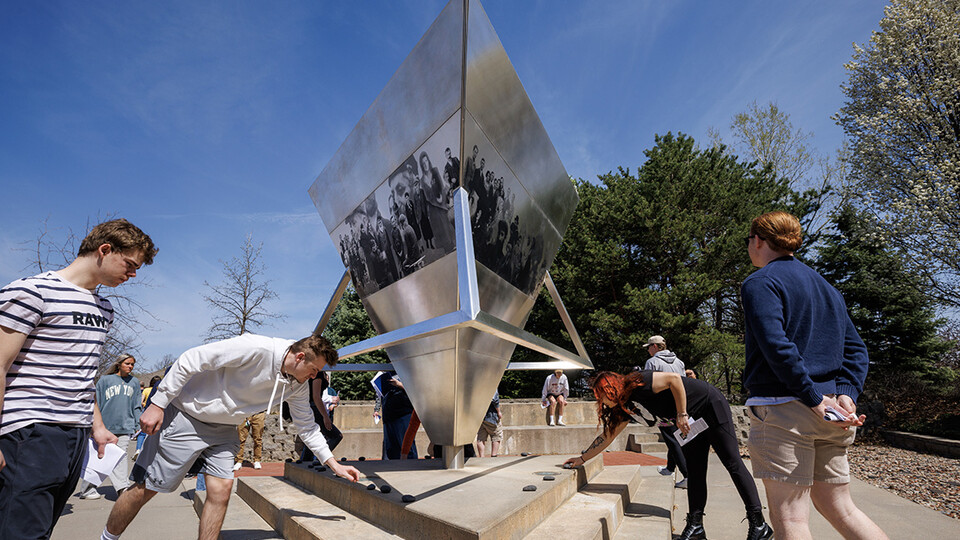On Holocaust Remembrance Day, a large group of University of Nebraska–Lincoln undergraduates stood quietly and reflected near the Nebraska Holocaust Memorial in Wyuka Cemetery.
Following a talk from instructor Gerald Steinacher, Rawley Professor of History, the students walked along the Sea of Stones representing the 11 million murdered during the Holocaust, read the names of victims with Nebraska relatives on the bricks among them, and took in the information from the Wall of Remembrance. Some walked the path through the tree-lined Butterfly Garden, placed in memory of the 1.5 million children who were systematically killed by the Nazis.
Maggie Nielsen, a double major in German and advertising and public relations, said the experience at the memorial was moving, especially because she is Jewish.
“It was really nice to see the responsiveness to the memorial,” she said. “It seems random to have such a thing in Nebraska, when you think about the grand scheme of things, but you realize, looking around and reading the names, there’s good reason for it to be here, and it was touching to see my non-Jewish classmates take part in something so meaningful. It was beautiful to witness.”
Steinacher asked the students afterward to write a reflection as they sat surrounded by the Sea of Stones and looking up to the gleaming metal, concrete and photos that formed the Star of Remembrance.
Reflections following experiences like this one, and interactions with second-generation survivors, are a key component to the class, History of the Holocaust, as Steinacher has centered the course design on helping students understand and more fully grasp the atrocities as well as what led up to them.
And, with the passage of time, that’s becoming harder, he said.
“We used to be able to bring survivors to class to talk directly with our students and share their stories,” Steinacher said. “That always had an impact by bridging the distance of space and time, but most survivors have now passed away, or are not able to travel because of age or poor health. We’re crossing the bridge between contemporary history — when we can remember things because we lived them — and history, when those who experienced it are no longer here.”
That fact, as well as rising antisemitism and Holocaust distortion, makes this class, and others like it, all the more important. For the last five years, Ari Kohen, Schlesinger Professor of political science and director of the Harris Center for Judaic Studies, and a team of Nebraska scholars including Steinacher, have been gathering data on best practices in Holocaust education, with the aim of making courses more meaningful and impactful for students.
“In general, there is a knowledge problem,” Kohen said. “We’ve seen data that tells us students are not learning about the Holocaust. But more than that, we’re seeing a caring problem. The timeliness of this project matters because there has been a dramatic resurgence in antisemitic incidences all over the country.”
In 2020, Kohen and Steinacher published the first article based in the findings of the pilot study. That article caught the attention of the Conference on Jewish Material Claims against Germany, based in New York, which has funded the research for four years.
With the funding, Kohen said they will be able to continue the mixed methods approach to learning how to teach about the history of the Holocaust in a way that resonates with students. Students who take the class and opt-in to participate are asked to complete a pre- and post-survey, take part in an interview about the course, and have their written reflections from the class coded and incorporated into the study. With the grant, Kohen said they’ve been able to add research strength to the team, including the addition of expertise from Nebraska’s Methodology and Evaluation Research Core. Kohen also hopes to incorporate alumni of the course into the surveys.
Most of the findings have lined up with the researchers’ hypotheses — that personal narratives and experiences are the most impactful, which can be realized with book choices and adding experiential learning into the syllabus.
“Overwhelmingly, students have mentioned the book ‘The Sunflower’ (by Simon Wiesenthal), as something that made them think differently,” Kohen said. “There are excellent historical texts on this time period, but they don’t seem to land the same way — it doesn’t stick with them.
“We’ve found there is something really impactful about the field trips, where students have visited a synagogue or the Holocaust Memorial or have had the opportunity to meet and speak with people who are Jewish. It seems like common sense, and things we’ve known as educators, but having quantitative information that shows these things work could help educators design more impactful courses everywhere.”
The funding will help cover costs to host a conference for educators in the future to talk about the findings and how to translate these best practices to both high school and undergraduate college courses. Kohen expects the team to welcome educators for these conferences in the final two years of the grant.
For students like Nielsen, the assigned readings, field trips, reflections and hearing personal stories have helped her delve much deeper into her understanding of the Holocaust.
“With my background in German, and being Jewish, I had preconceptions and notions that I knew everything about the Holocaust, but this class has challenged those notions and made me rethink how I approach this era,” Nielsen said. “We read the book ‘Ordinary Men,’ which was about people who weren’t targeted, but were still affected because they were forced to become perpetrators. I had always assumed that they were willing, joyful participants, but I’ve realized many were doing what they thought they had to do to not become another target.”
